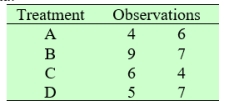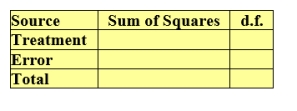Essay
Consider the following data:

A) Obtain the arrays that show a decomposition for the observations. That is, complete the following arrays.

B) Find the sum of squares for each array. That is, find Treatment S.S, Residual S.S, Mean S.S, Total S.S, Total S.S (Corrected), respectively.
C) Determine the degrees of freedom for each sum of squares. That is, determine Error d.f.
and Treatment d.f., respectively.
D) Summarize by completing the ANOVA table.

Correct Answer:

Verified
Correct Answer:
Verified
Q1: Using the table of percentage points for
Q2: Consider the following ANOVA table.<br> <img src="https://d2lvgg3v3hfg70.cloudfront.net/TB10841/.jpg"
Q4: Consider the following data:<br> <img src="https://d2lvgg3v3hfg70.cloudfront.net/TB10841/.jpg" alt="Consider
Q5: Consider the following data:<br> <img src="https://d2lvgg3v3hfg70.cloudfront.net/TB10841/.jpg" alt="Consider
Q6: Taking <span class="ql-formula" data-value="\alpha"><span class="katex"><span
Q7: 16 Three processes for creating flame-retardant fabric
Q8: Consider the following data:<br> <img src="https://d2lvgg3v3hfg70.cloudfront.net/TB10841/.jpg" alt="Consider
Q9: There are four lecture sessions for a
Q10: The following table is associated with the
Q11: Four drug stores have a pharmacy which